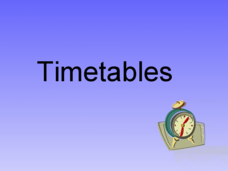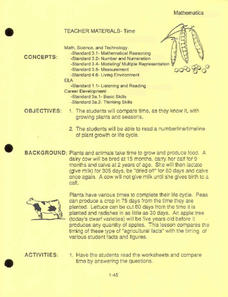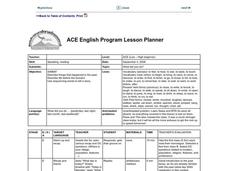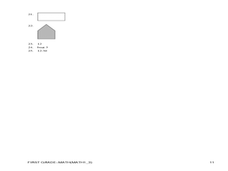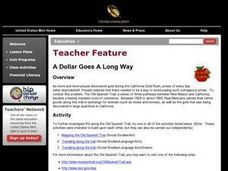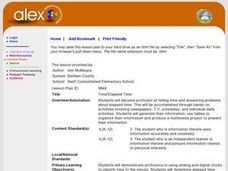Curated OER
Speed Problems
Return to the classic word problem with these speed scenarios. Learners use some combination of the variables speed, distance, and speed to solve six problems, all of which ask for one of these as an answer. The examples do a nice job of...
Curated OER
Clocks and Watches
Telling time is an important skill. Beginners to this concept determine the time to the nearest half hour using both digital and analog clocks. There are two examples here demonstrating the form scholars should use when recording each...
Curated OER
Time Worksheet-on the Hour
Use this as an introduction to telling time in Spanish. Your beginning Spanish speakers match 10 digital and analog clocks with the Spanish time expression. Include some oral practice through call-and-response to reinforce the new...
Curated OER
Our Solar System - Comparing Planetary Travel Distances
NASA presents a mini-unit on distances in our solar system. It incorporates scientific concepts of gravity, mass, density, and payload while your aspiring astronauts also employ mathematics skills. They calculate speed, they determine...
Curated OER
The Parachute
Students discuss parachutes and write a procedure to determine the effect of different size parachutes and different masses on the time it takes the masses to fall. They record all their data from their experiment then write three...
Curated OER
Acceleration Lab
Young Einsteins experiment with the acceleration of Hot Wheels™ toy cars down inclined planes at various angles. This classic physics lab activity is thoroughly explained in both a teacher’s guide and a student lab sheet. Science...
Curated OER
In the Right Order
What comes first? Practice order of events with this sequencing activity. Learners examine two sets of pictures and write 1st, 2nd, and 3rd beneath the corresponding pictures. Encourage them to explain their reasoning, as there may be...
Curated OER
Time On My Hands
Young learners engage in discussions and activities on telling time, different types of clocks, and how the parts of a clock actually work. The engage in interactive websites, hands-on games, and watch a video on the art of the clock and...
Curated OER
Telling Time to the Hour
Here is a very good presentation on telling time using analog clocks. Youngsters are coached on how to tell time to the top of the hour by being taught about the difference between the hour hand and the minute hand. Some clear...
Curated OER
Timetable Problems
Learning how to read a schedule and determine when you will depart and arrive is an everyday skill that builds competency in chart reading, subtraction, elapsed time, and counting on. Learners discuss how to solve timetable problems and...
Curated OER
Time
An interesting instructional activity focuses the growth cycles of plants and animals. Learners look at plants like radishes, peas, and apples, and compare their growth cycles to those of dairy cows. Some very good worksheets are...
Curated OER
Time Game!
Looking for a good presentation to use when teaching how to tell time on analog clocks? Then this PowerPoint is for you! In it, learners practice reading the correct time on clocks. All of the times are at the top of the hour, so this is...
Curated OER
Telling the Time
Introduce the concept of time and all its implications. Kids discover facts about minutes, seconds, days, weeks, months, and years. They label the parts of an analog and digital clock then practice telling the time to the quarter hour.
Curated OER
Ordinal Numbers Worksheet
“Circle the third dog in the row.” The four cleverly illustrated worksheets in this packet give your mathematicians practice with ordinal numbers. Younger learners might need assistance reading the prompts. An answer sheet is provided.
Curated OER
Morning Math
Here is a series of morning math activities which will get your class thinking as they start the day. Simply do one or two every day; the variation in types of math will keep them on their toes and reviewing past concepts. Each of the 16...
Curated OER
Half Past Times
Learning how to tell time on an analog clock can be tricky for some kids. Start with the basics and teach them to determine the half-past time. There are five clocks shown. Learners draw in the times indicated, each time is half-past the...
Curated OER
What Did You Do?
English learners practice using the past tense by participating in a time description activity. They identify the differences between verbs when they are used to describe current events or past events. Students answer questions using...
Curated OER
First Grade Math: 1-3
For this first grade math review worksheet, 1st graders answer multiple choice questions about symmetry, money, measurement, time, and more. Students complete 25 questions.
Curated OER
Clock Randomizer: Telling Time
How fun! You push the letter 's' and the clock randomizer kicks into high gear, you push 's' again and it stops on a random analog clock face. Your kids then jump in and tell you what time is indicated on each clock they see. A fun way...
Curated OER
A Dollar Goes A Long Way
Investigate life along the Old Spanish Trail! They visit websites and identify the history and environment. They create journals, dramatic enactments, and maps to discover the role individuals played in society. They also explore the...
Curated OER
Math Cross, Puzzle #26
Here is a measurement, money and time activity which invites learners to solve twenty-eight math problems utilizing addition, subtraction and multiplication strategies to complete a math crossword puzzle.
Curated OER
Rock Around the Clock Math
An engaging and fun instructional activity on telling time is here for you. In it, young time-tellers listen to the song, "Rock Around the Clock," then use Judy Clocks to practice telling time to the hour and half hour. Finally, using...
Curated OER
Time to Cook!
Don't let the cupcakes burn! Using cooking procedure, learners practice drawing minute and hour hands onto five analog clock faces. They read five scenarios which require them to add time increments to find the time required for each...
Curated OER
Time/Elapsed Time
Young mathematicians complete various activities to demonstrate proficiency in telling time and identifying elapsed time. They analyze and discuss television schedules, create a booklet about their daily activities, produce a TV. guide,...











